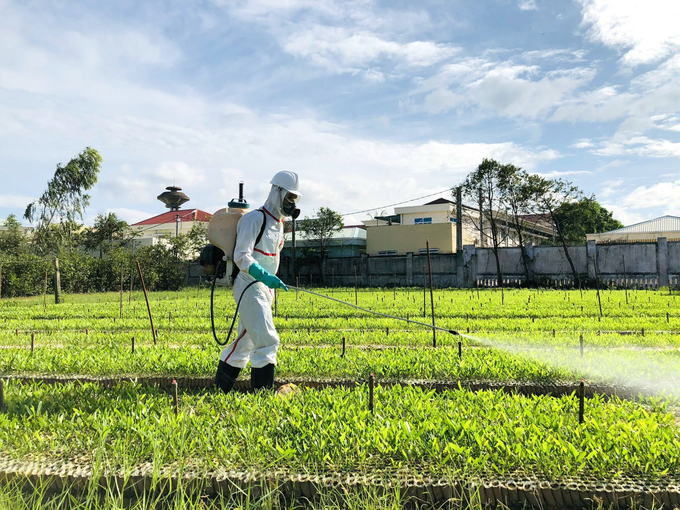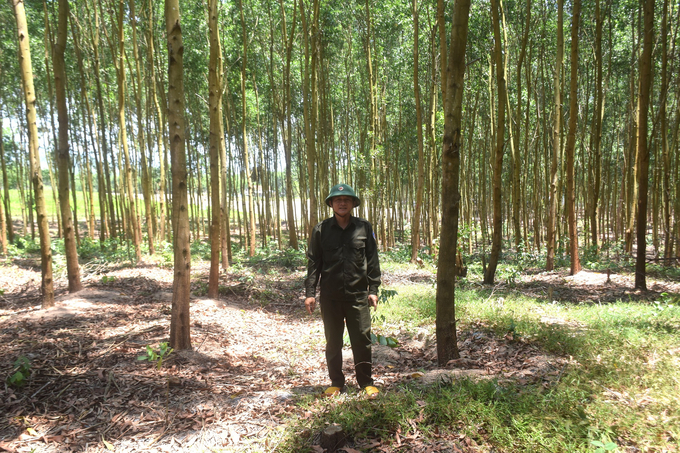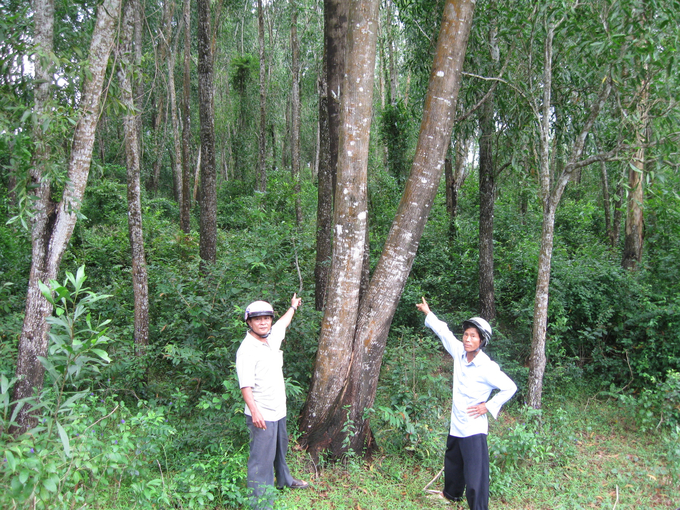June 23, 2025 | 10:28 GMT +7
June 23, 2025 | 10:28 GMT +7
Hotline: 0913.378.918
June 23, 2025 | 10:28 GMT +7
Hotline: 0913.378.918

Quy Nhon Forest Co., Ltd (Binh Dinh) produces forest plant seeds using tissue culture technology. Photo: V.D.T.
Binh Dinh province currently has 173 establishments specializing in the production and trade of forestry seedlings with an average output of 200 million seedlings/year. Among them, three enterprises produce tissue culture seeds, including Quy Nhon Forest Co., Ltd, Vu Ha Co., Ltd, and Nguyen Hanh Plant Services Private Enterprise. Since the beginning of 2023, forest seedling production facilities have supplied nearly 123 million seedlings of all types to the market.
As per the plan, Binh Dinh will plant 8,780 ha of forest in 2023, including 160 ha of protection forests and special-use forests, and the rest is production forest. Since the start of 2023, localities have planted nearly 2,890 ha of forest. Binh Dinh is in the rainy season, which is the time for the main forest planting season, and units operating in Binh Dinh’s forestry industry are ready.
“In recent years enterprises and forest planting households in Binh Dinh have made a strong shift to planting large timber species. They have also switched from using cuttings to tissue culture seedlings, aiming to improve the overall quality of planted forests as well as their productivity and economic efficiency,” said Nguyen Dinh Lam, Head of Forest Management and Development (Binh Dinh Forest Protection Department).

Forestry tree seed garden of Quy Nhon Forest Co., Ltd (Binh Dinh). Photo: V.D.T.
According to Pham Ba Hieu, Deputy Head of the Department of Forest Protection and Management Technique (Quy Nhon Forest Co., Ltd), the company produces two types of forest species, acacia and eucalyptus, applies both the cutting and tissue culture methods, but tissue culture seedlings hold the majority.
The plan of Quy Nhon Forest Co., Ltd for 2023 is to plant 195 ha of production forest and more than 63 ha of replacement forest. Up to now, the company has completed the work of digging holes and basal application of fertilizing. After the first rains of the season, the company has begun planting. The 2023 afforestation work is expected to be completed by the end of November.
In the case of Ha Thanh Forestry Co., Ltd (Van Canh district, Binh Dinh), between 2016 and 2020, the company planted large timber forests with a total area of more than 1,659 ha, of which more than 298 ha was newly planted forests, more than 732 ha of post-exploitation replanted forests and more than 628 ha of converted forests. For the 2021 - 2025 period, Ha Thanh Forestry Co., Ltd will continue to plant 1,407 ha of larger timber forest.

Large timber forest of Song Kon Forestry Co., Ltd (Binh Dinh) planted in Tay Son district. Photo: V.D.T.
Nguyen Ngoc Dao, Chairman of Song Kon Forestry Co., Ltd (Vinh Thanh district, Binh Dinh) said that according to the plan for the period 2023 - 2025, the company will exploit small timber forests and replant nearly 287 ha of large timber forests. In particular, more than 89 ha of large timber forests will be exploited and replanted in Dak Mang and Bok Toi communes (Hoai An district) this year. In 2024, the plan will proceed in the communes of Dak Mang and Bok Toi (Hoai An district) and Vinh Quang commune (Vinh Thanh district) with a total area of 117.5 ha. In 2025, Song Kon will continue to plant new trees in Dak Mang commune, expecting 80 ha.

In recent years, businesses operating in the forestry industry and forest planting households in Binh Dinh have strongly shifted to planting large timber forests. Photo: V.D.T.
At present, Binh Dinh has 3,175 ha of large timber forests, striving to increase to 4,450 ha by the end of this year, 10,000 ha in 2025 and 30,000 ha in 2035. Aiming to improve the quality of planted forests, the province plans to tighten the quality management of forest seedlings. Binh Dinh authorities regularly coordinate with localities to organize inspections of forest seedling production and trading activities in the area.
“To effectively monitor the quality of forest seedlings, Binh Dinh Sub-Department of Forest Protection has established a council to appraise the source of forest species when the seed production unit has an application for recognition of the seed source. The personnel of the appraisal council includes the staff of the Department of Forest Protection and the General Planning Office (under Binh Dinh Department of Agriculture and Rural Development), experts and representatives of the Department of Agriculture and Rural Development of districts and towns. This is the force that provides consults so that Binh Dinh Department of Agriculture and Rural Development makes the decision to recognize seed sources," said Le Duc Sau, Deputy Director of Binh Dinh Sub-Department of Forest Protection.
Translated by Samuel Pham
![Turning wind and rain into action: [9] Digitizing hydrometeorological data in response to climate change](https://t.ex-cdn.com/nongnghiepmoitruong.vn/608w/files/news/2025/06/17/z6704423696987_15fd32ffc26d590d204d520c9dac6786-nongnghiep-165943.jpg)
(VAN) Farmers have begun accessing hydrometeorological applications to adjust their cropping schedules, aiming to ensure productivity and adapt to climate change.
![Turning wind and rain into action: [8] Real-time salinity detection and early warning technology](https://t.ex-cdn.com/nongnghiepmoitruong.vn/608w/files/news/2025/06/17/z6704423696987_15fd32ffc26d590d204d520c9dac6786-nongnghiep-151127.jpg)
(VAN) Thanks to the integration of modern hydrological-hydraulic models, remote sensing technologies, and artificial intelligence, the accuracy of hydrological forecasting has significantly improved.
![Turning wind and rain into action: [7] Early disaster warnings help marine farmers minimize losses](https://t.ex-cdn.com/nongnghiepmoitruong.vn/608w/files/news/2025/06/17/z6704423696987_15fd32ffc26d590d204d520c9dac6786-nongnghiep-142942.jpg)
(VAN) In recent years, thanks to early disaster warnings and forecasting, marine farmers in Khanh Hoa province have been able to reduce risks and losses, thereby improving production efficiency.
![Turning wind and rain into action: [6] ‘Four on-the-spot’ disaster management software](https://t.ex-cdn.com/nongnghiepmoitruong.vn/608w/files/news/2025/06/17/e5a48259d6a262fc3bb3-nongnghiep-183800.jpg)
(VAN) By simply activating the scenario on the disaster management software, the relevant authorities immediately know how many households need to be evacuated, where to evacuate them to, and by what means of transportation…
![Turning wind and rain into action: [5] Hue applies modern technology in disaster forecasting](https://t.ex-cdn.com/nongnghiepmoitruong.vn/608w/files/news/2025/06/17/z6704423696987_15fd32ffc26d590d204d520c9dac6786-nongnghiep-093938.jpg)
(VAN) In Hue city, modern technology has recently been applied in meteorological and hydrological forecasting and warning, helping to reduce the damage caused by natural disasters.

(VAN) A cutting-edge farming technique being implemented on an experimental ranch in Arizona's Sonoran Desert has already saved a billion gallons of water over five years, according to Civil Eats.

(VAN) Poultry and pig production and the environment can be boosted through enhanced water technology, according to new research.